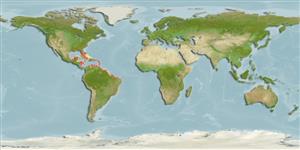Environment: milieu / climate zone / depth range / distribution range
экология
морской; солоноватоводный ассоциированный с рифами; мигрирует в океане; пределы глубины 0 - 5 m (Ref. 5227). Subtropical; 45°N - 40°S, 98°W - 32°W
Western Atlantic: south Florida (USA), through the Caribbean and along the coasts of Central and South America to Uruguay.
Length at first maturity / Size / Вес / Возраст
Maturity: Lm 18.9 range ? - ? cm
Max length : 30.0 cm TL самец/пол неопределен; (Ref. 5217); common length : 20.0 cm SL самец/пол неопределен; (Ref. 3723)
Body elongate; lower jaw very prolonged; upper jaw short, triangular, and scaly; lower branch of first gill arch with 29 to 38 gill rakers; fins lacking spines; pectoral fins not very long; caudal fin emarginate or slightly forked; anal fin with 15 to 18 rays; back greenish, with 3 narrow, dark, bars; flanks and belly silvery white; fleshy border of lower jaw red; caudal fin light colored with dark tips (Ref. 55763).
An inshore, surface-dwelling species forming sizeable schools, frequently entering estuaries (Ref. 3723). Uncommon over reefs (Ref. 9710). Omnivorous, feeds on algae and other small animals (Ref. 3723). Caught with 'mandinga' nets in Venezuela, often using lights (Ref. 3723). Edible but not really appreciated (Ref. 3723).
Life cycle and mating behavior
Maturities | размножение | Spawnings | Egg(s) | Fecundities | личинки
Robins, C.R. and G.C. Ray, 1986. A field guide to Atlantic coast fishes of North America. Houghton Mifflin Company, Boston, U.S.A. 354 p. (Ref. 7251)
Статус Красного Списка МСОП (Ref. 130435)
Угроза для людей
Reports of ciguatera poisoning (Ref. 30911)
Использование человеком
рыболовство: не имеет хозяйственного значения; наживка: usually
дополнительная информация
инструменты
Специальные отчеты
Скачать в формате XML
ресурсы в Интернет
Estimates based on models
Preferred temperature (Ref.
123201): 22.9 - 28.1, mean 27.3 °C (based on 769 cells).
Phylogenetic diversity index (Ref.
82804): PD
50 = 0.5000 [Uniqueness, from 0.5 = low to 2.0 = high].
Bayesian length-weight: a=0.00234 (0.00179 - 0.00307), b=3.09 (3.03 - 3.15), in cm total length, based on LWR estimates for this species (Ref.
93245).
Trophic level (Ref.
69278): 2.0 ±0.0 se; based on diet studies.
Generation time: 0.8 ( na - na) years. Estimated as median ln(3)/K based on 1
growth studies.
устойчивость к внешним воздействиям (Ref.
120179): высокий, минимальное время удвоения популяции до 15 месяцев (Preliminary K or Fecundity.).
Fishing Vulnerability (Ref.
59153): Low vulnerability (15 of 100).
Nutrients (Ref.
124155): Calcium = 234 [47, 570] mg/100g; Iron = 1.01 [0.31, 3.13] mg/100g; Protein = 18.9 [15.8, 21.3] %; Omega3 = 0.156 [0.056, 0.474] g/100g; Selenium = 13.1 [4.2, 47.4] μg/100g; VitaminA = 47.8 [8.0, 301.1] μg/100g; Zinc = 1.65 [0.61, 4.77] mg/100g (wet weight);
